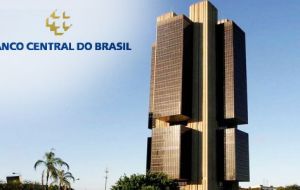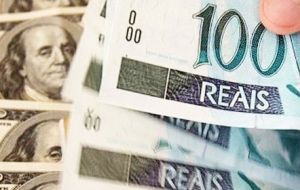MercoPress. South Atlantic News Agency
Brazil central bank slashes money cost; estimates Selic rate at 8.5% by end of the year
 “The evidence suggests a gradual resumption of economic activity,” the central bank said in a statement.
“The evidence suggests a gradual resumption of economic activity,” the central bank said in a statement.  “This moderate intensification of the pace of monetary easing, relative to the pace set in the January and February Copom meetings, is, at this time, appropriate”
“This moderate intensification of the pace of monetary easing, relative to the pace set in the January and February Copom meetings, is, at this time, appropriate”  “This scenario assumes a path for the policy interest rate that ends 2017 at 8.5% and remains at that level until the end of 2018”.
“This scenario assumes a path for the policy interest rate that ends 2017 at 8.5% and remains at that level until the end of 2018”. Brazil's Central Bank cut the key interest rate by a full one percentage point on Wednesday in an effort to inject life into the floundering economy. This was the fifth straight cut, taking the key Selic rate to 11.25%.
”The evidence suggests a gradual resumption of (economic) activity,” the bank said in a statement. In a unanimous vote, the bank's 9-member monetary policy committee, Copom, decided to lower its benchmark Selic rate by 100 basis points from 12.25% to 11.25%, marking the biggest reduction since June of 2009.
In February, the bank made a 0.75 percentage point cut but falling inflation has created even greater leeway to stimulate the economy, market analysts say.
Brazil is into its third year of recession and although it is forecast to return to weak growth later this year, unemployment is at more than 13%, meaning few Brazilians are feeling the effects of the reported recovery.
Rate cuts began last October, starting from a high of 14.25%, and Wednesday's cut was the biggest so far. Analysts say that the Selic is likely to fall as low as 8.5% by the end of this year, then likely stay there next year until presidential elections are held.
In April, Brazil registered its lowest quarterly inflation since 1994 at 0.96%. Annual inflation is currently 4.57%. Analysts expect inflation to end at 4.09% this year, under the official target of 4.5%.
The economy, however, remains stubbornly stuck in the country's worst recession on record. GDP shrank 3.6% last year and 3.8% in 2015. In March, the government lowered its forecast for this year to annual growth of just 0.5%, down from one percent.
The Copom release follows: The Copom unanimously decided to reduce the Selic rate by one percentage point, to 11.25 percent per year, without bias. The following observations provide an update of the Copom's baseline scenario:
The set of indicators of economic activity released since the last Copom meeting remains consistent with stabilization of the economy in the short run. Available evidence suggests a gradual recovery of economic activity during the course of 2017;
The global outlook remains quite uncertain. Nevertheless, developments have so far mitigated the effects on the Brazilian economy of possible changes in economic policy in some large economies, notably in the United States. There is uncertainty regarding the sustainability of global economic growth and the stability of current commodity price levels;
Inflation developments remain favorable. The disinflation process is more widespread, and disinflation of IPCA components that are most sensitive to the business cycle and monetary policy has consolidated. Food price disinflation constitutes a favorable supply shock;
Inflation expectations for 2017 collected by the Focus survey are around 4.1%. Expectations for 2018 remain around 4.5%, and expectations for 2019 and longer horizons are slightly below that level;
The Copom's inflation forecasts for 2017 and 2018 in the scenario with interest rate and exchange rate paths extracted from the Focus survey are around 4.1% and 4.5%, respectively. This scenario assumes a path for the policy interest rate that ends 2017 at 8.5% and remains at that level until the end of 2018.
The Committee emphasizes that its baseline scenario involves risks in both directions: (i) the highly uncertain global outlook might make disinflation more difficult; (ii) the approval and implementation of reforms – notably those of fiscal nature – and of adjustments in the Brazilian economy are important for the sustainability of disinflation and for the reduction of its structural interest rate; (iii) the favorable food-price shock might produce second-round effects and, thus, contribute to additional reductions of inflation expectations and inflation in other economic sectors; and (iv) the recovery of economic activity might be more (or less) gradual and delayed than currently anticipated.
Taking into account the baseline scenario, the balance of risks, and a wide array of available information, the Copom unanimously decided to reduce the Selic rate by one percentage point, to 11.25 percent per year, without bias. This moderate intensification of the pace of monetary easing, relative to the pace set in the January and February Copom meetings is, at this time, appropriate. The Committee judges that convergence of inflation to the 4.5% target over the relevant horizon for the conduct of monetary policy, which includes 2017 and, with a gradually increasing weight, 2018, is compatible with the ongoing monetary easing process.
The Copom judges that the extension of the monetary easing cycle will depend not only on estimates of the structural interest rate of the Brazilian economy, which the Committee will continue to reassess over time, but also on the evolution of economic activity, on the other aforementioned risk factors, and on inflation forecasts and expectations.
The Copom emphasizes that the pace of monetary easing will depend on the estimated extension of the cycle and on the degree of frontloading. In turn, the latter will depend on the evolution of economic activity, on the other aforementioned risk factors, and on inflation forecasts and expectations. The Committee considers the current pace of easing to be appropriate; however, the current economic context calls for monitoring the developments of the determinants of the degree of frontloading of the cycle.
The following members of the Committee voted for this decision: Ilan Goldfajn (Governor), Anthero de Moraes Meirelles, Carlos Viana de Carvalho, Isaac Sidney Menezes Ferreira, Luiz Edson Feltrim, Otávio Ribeiro Damaso, Reinaldo Le Grazie, Sidnei Corrêa Marques, and Tiago Couto Berriel.




Top Comments
Disclaimer & comment rulesCommenting for this story is now closed.
If you have a Facebook account, become a fan and comment on our Facebook Page!